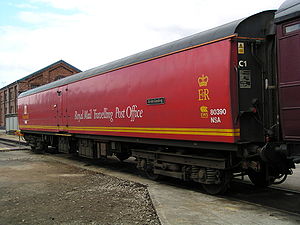| British Rail Post Office sorting van | |
|---|---|
 NSA 80390 "Ernie Gosling" on display at Doncaster Works open day on 27 July 2003. This vehicle was operated by EWS country-wide in the consist of TPO mail trains | |
| In service | 1959–2004 |
| Manufacturer | BR Wolverton & York |
| Family name | British Railways Mark 1 |
| Constructed | 1959, 1961, 1968–69, 1972–73, 1977 |
| Number built | 81 (new), 15 (converted from SK) |
| Operators | British Rail |
| Specifications | |
| Car length | 64 ft 6 in (19.66 m) |
| Width | 9 ft 3 in (2.82 m) |
| Height | 12 ft 9+1⁄2 in (3.90 m) |
| Maximum speed | 90–100 mph (145–161 km/h) |
| Weight | 35–39 tonnes (34.4–38.4 long tons; 38.6–43.0 short tons) |
| HVAC | Dual heat (steam and electric), ETH 3 or 4 |
| Bogies | BR2 or B5 |
| Braking system(s) | 1959–61 stock: Vacuum, 1968–77 stock: Dual (Air and Vacuum) |
| Track gauge | 4 ft 8+1⁄2 in (1,435 mm) |
A Post Office sorting van is a type of rail vehicle built for use in a Travelling Post Office.
British Rail built ninety-six of these vehicles between 1959 and 1977, to several similar designs, all based on the Mark 1 coach design. They were numbered in the range 80300–80395. The earliest vehicles built featured catching nets and collection arms, to allow mail bags to be exchanged without the train needing to stop, a practice which continued until 1971. Following the Great Train Robbery, vehicles from 80319 onwards featured a revised design with smaller windows.
In the early 1970s, British Rail introduced the TOPS classification system. Vehicles were given the TOPS code NS, followed by an A if they were air-braked, V if vacuum-braked, or an X if they had both air and vacuum brakes.